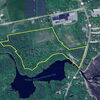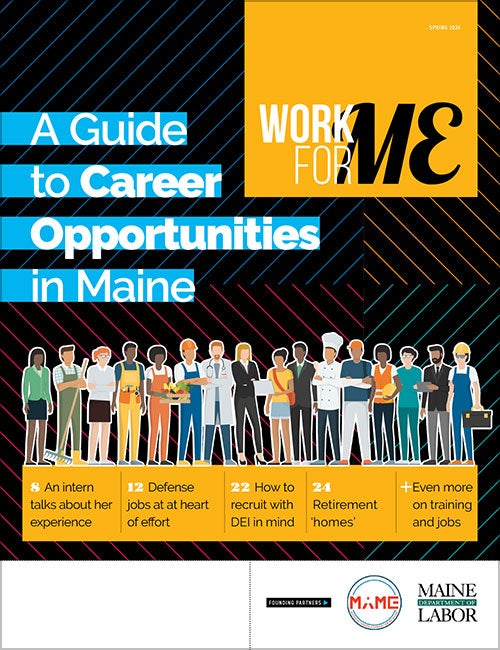Processing Your Payment
Please do not leave this page until complete. This can take a few moments.
Demographic destiny | The aging of Maine's population portends a conflict between health care and education spending
But even with that experience, Cobb isn't sure what it will mean for Maine when its elderly population more than doubles in the next 20 years. "That question is more complex than any of us recognize at this time," she says.
According to U.S. Census data released last month, Maine now holds the title of oldest state in the nation, with a median age of 40.6 years. That number undoubtedly will continue to rise, though, as Maine's population age 65 and older grows a projected 72%, to 327,000, by 2025. At that point, one in five Mainers will be elderly, and the ratio of working-age Mainers to elderly citizens will have fallen from about 5-1 to just under 3-1.
Such a significant demographic shift will inevitably carve deep impressions in Maine's social and economic landscape. Economists and policy experts anticipate myriad impacts, ranging from huge issues such as a looming workforce shortage as those elderly retire (see "Opportunity knocks," p. 23) to smaller questions of urban planning and transportation planning: How will Maine shuttle its elderly population around the state as those residents give up cars for health reasons?
To many observers, though, the question of elderly health ˆ and health care ˆ is the most obvious issue facing Maine over the next two decades. As a group, the elderly account for more than a third of health care spending nationwide. Those numbers have ramifications for every state, considering that Medicaid is the single-largest payer of long-term care services, such as assisted living or nursing home care, according to a 2003 Georgetown University study. While the baby boom generation is expected to be healthier than their parents and grandparents as they age, they're also expected to live longer than their forebears, meaning Maine could be paying less per person, but for many more years.
With overall health care spending now accounting for more than $800 million annually, many in Maine wonder how the state can support a potential increase in costs as its population ages. But when looking at health care costs in the context of the overall budget, others see a bigger question: How will a growing elderly population, combined with a shrinking school-age population, affect what have been traditional budget priorities? "The defining issue of Maine policy going forward will be the war between health care and education," says Charles Colgan, a professor of public policy and management at the University of Southern Maine's Muskie School of Public Service.
Though Colgan can't predict whether health care will overtake K-12 education as the single largest expenditure in the state budget, he and others anticipate both State House debates and local battles over the competing expenditures. And no matter what happens with funding levels, Maine's health and education experts say they're already seeing the need for changes in how Maine delivers health and education services in light of the aging population.
More elders, fewer kids
For more than a decade, elder-care experts have been adapting the health care system to better suit the coming generation of senior citizens ˆ namely, aging baby boomers who are expected to be more active in retirement. One area of particular interest to Kathy Cobb and the Bureau of Elder and Adult Services is long-term care, which provides ongoing medical and social services to the elderly, disabled and chronically ill.
Decades ago, long-term care for the elderly meant a spot in a nursing home. The majority of elderly citizens today, however, want nothing to do with traditional nursing homes, says Cobb. In response, retirement communities and hospitals have developed options that range from visiting homecare services to assisted living facilities to cater to senior citizens with differing medical needs (see "The circle of life," p. 20).
But for middle- to low-income residents who can't afford a private retirement community, Maine has been exploring ways to deliver similar services under MaineCare, the state's Medicaid program. In the mid-90s, Cobb worked on a project that offered tax credits to private developers who built assisted-living facilities such as Merry Gardens in Camden, which offers on-site medical services covered by MaineCare.
The program has since expanded to six pilot facilities around the state, helping Maine avoid the expense of building and maintaining new nursing homes, according to Cobb. However, she admits that delivering medical and social services is less expensive in a nursing home, because it's more efficient for a staff to handle multiple patients when they are clustered in one institution, rather than bringing those services into individual patients' homes or apartments.
Already, though, Cobb says Maine has long waiting lists for its long-term care programs. "There are not enough funds to serve everyone who wants to access those programs," says Cobb. "So as the number [of elderly] grow, we are concerned about how we're going to serve the need."
Members of Maine's education community also have concerns about the future, but for the opposite reason: The number of pupils in Maine is projected to decline 12.5% over the next 10 years, making a reduction in education funding and infrastructure a distinct possibility. "With Maine being organized into 286 school administrative units, we're facing the difficult question of those enrollment declines and how to be more efficient in administering education," says Jim Rier, policy director of school funding for the Maine Department of Education.
While Rier supports the idea of sharing administrative services and even consolidating some schools, he's seen how controversial the topic is in communities used to local control of education. Most recently, a new study by the Margaret Chase Smith Policy Center at the University of Maine that found school consolidation could delivery big cost savings with little impact on education quality drew immediate criticism from some lawmakers and educators.
But Rier and Mark Gray, executive director of the Maine Education Association, a union representing Maine teachers, see potential for that debate to intensify if a growing elderly population ˆ presumably without children in the school system ˆ begins questioning the amount of money spent on education.
For that reason, Gray agrees that Maine should eliminate duplicative administrative services and look for other efficiencies outside of the classroom. Besides administration and infrastructure, though, Gray says the state should examine programs and policy decisions that may make Maine schools less efficient. He cites as an example the Maine Learning Results assessment system, which teachers claim covers so many areas that it interferes with regular teaching duties. (Earlier this month, Gov. John Baldacci proposed streamlining the system. The Legislature had not voted on those changes before this issue of Mainebiz went to press.)
Looking ahead, if health care and education expenditures begin competing directly for limited resources, Gray expects such programs will be under increased scrutiny. "We've got to make doubly sure the resources we're spending are producing the results we expect," says Gray.
Aging is obvious
Despite the piles of demographic data pointing to Maine's population shift, the question remains whether the Legislature can prepare for the kinds of long-term policy and budgetary changes that might be required. Craig Nelson, an Augusta-based attorney and lobbyist for assisted living and retirement homes, isn't so sure. "One of the problems we have in this state ˆ and I think it's true in most states ˆ is what I call 'biennial tunnel vision.' We only look at these issues in the context of a two-year budget," says Nelson. "If you were running a business, you'd look down the road at least three to five years, maybe even 10 years, to anticipate major issues."
That biennial focus has only become more intense as the Legislature has scrambled to fill gaps in recent budgets. Not surprisingly, financial uncertainty has meant sudden changes in the services the state provides. Last year, the Bureau of Elder and Adult Services had to absorb $1.75 million in unexpected budget cuts, according to Cobb, forcing it to reduce the number of hours of assistance per week senior citizens could receive from the Homemaker program, among other changes. She adds, "How are we going to avoid having people lose services because of fluctuations in state revenues?"
That's not to say there's been no long-term planning done on this issue, however. In 2003, Baldacci established a task force to examine efficiency measures for Maine's education system. Among other findings, the group's 2004 report recommended regionalization of administrative services and consolidation of schools ˆ ideas that found little support in the Legislature, says Rier. But out of that discussion came one idea ˆ since adopted as part of LD 1, the tax reform initiative ˆ to create a fund to help individual school districts pay for their own efficiency measures. That way, says Rier, if schools in a region decide to consolidate some of their administrative services, the state will have money available to help fund the transition.
In the health care arena, Cobb points to state initiatives such as Dirigo Health's focus on chronic disease prevention as ways to help reduce future medical costs. But the shouting over Maine's current health care system and its rising costs already has grown deafening ˆ even without the potential impact of 137,000 more elderly in the state.
Lobbyists like Craig say MaineCare's reimbursement rate ˆ about 80% ˆ already is squeezing service providers. Critics such as the Maine Heritage Policy Center question efforts to expand MaineCare eligibility to childless adults and residents with incomes further above the poverty level when the state is facing a potential influx of seniors into the system over the next 10 years. Baldacci and Trish Riley, director of the Governor's Office of Health Policy and Finance, have argued that allowing the Mainers to remain uninsured would be more costly in the long run.
Sen. Arthur Mayo (D-Bath), chair of the Legislature's Health and Human Services Committee, also sees value in providing health insurance to as many Mainers as possible. And while he acknowledges the difficulty of examining long-term policy questions in the context of the biennial budget wrangling, he believes lawmakers aren't ignoring the potential impact of Maine's demographic shift.
In fact, he expects that lawmakers, the governor's office, various agencies and the private sector will come together either this year or next to create some kind of long-range planning effort, perhaps a blue-ribbon commission examining the impacts of Maine's aging population. "We've got to look at it," Mayo says. "We just can't wake up in 2010 and say, 'Uh oh.'"
In the end, the fact that it is so unsurprising makes Maine's aging population a particularly interesting policy phenomenon, says Colgan. "A lot of issues that confront government you never see coming," he says. "But some are blindingly obvious, and getting older is one of them. It's obvious on societal level and a personal level."
Unfortunately, it looks like adjusting to the change won't be any easier just because we've been given fair warning.










Comments